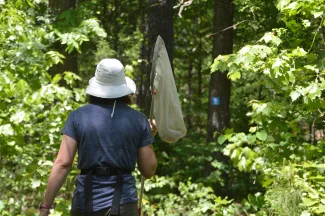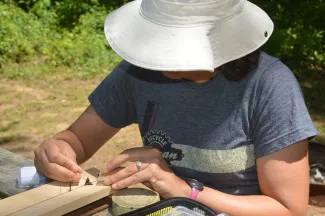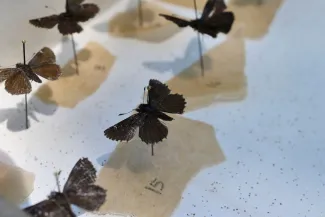Blackberry bushes growing along roadside creeks attract a number of pollinators in spring, inluding a wide variety of butterflies. But the bright colors and buoyant flights of the most familiar of butterflies don't distract Katrina Menard, former curator at the Sam Noble Museum of Natural History.

Katrina Menard hikes through the woods with her butterfly net in search of Linda's roadside-skipper.
"We're looking for a tiny, dark butterfly about an inch long. It will be hopping around the rocks in the sun to get warm."
Her mission: find a Linda's roadside-skipper - a modest member of the skipper family, the broadest category of butterflies. Before her project began, all Oklahoma records of the butterfly had been from visual observations. No specimens had been collected to verify those sightings.
Menard has been searching for the skittish butterfly in and around state parks in southeastern Oklahoma for four years. She's been examining blackberry brambles near creeks, small mud puddles, and patches of Indian woodoats from March to June each year. With the help of a fellow entomologist, she's been able to collect and positively identify a small number of the rare butterfly.

Katrina Menard works to mount a roadside-skipper she collected in southeastern Oklahoma.
"The adults really like to feed, or nectar, on the blackberry blossoms. And the woodoats serve as a host plant for the larvae."
The grass can be found across Oklahoma, but Linda's roadside-skippers have only been spotted in a limited area, leading to a key question of the study: why?
"In terms of conservation, if we don't know why they're in Oklahoma, or why they're only in certain areas of Oklahoma, we won't know how to help them. We won't know which conservation efforts would be most beneficial for these butterflies."
Menard is also interested in studying the genetic differences between Linda's roadside-skippers and the more widespread common roadside-skipper.
"What we're finding is a complex of very related species, and the morphological, or physical, differences are subtle."
With hopes of collecting both butterfly species for genetic tests, Menard continues her walk along a park trail with a net in hand. "I typically start the search in midmorning. Butterflies are exothermic and need to sit on leaves and rocks to get warm. If I start the search too early, they won't be active."
As she scans the creekside blackberries, she notices a familiar movement.
"Both Linda's and common roadside-skippers are very fast in flight and fold their wings up like an F-16 when perched," Menard said. "They can easily blend in with shadows and are difficult to see when perched. A lot of times you have to wait for them to move in order to spot them."
When the butterfly in question lands with wings held high, Menard raises a net and quickly catches the dark skipper. As she slips the butterfly into a vial, she notes the small, white dots on the edge of the wing. "This is probably the common roadside-skipper, but DNA will have to confirm."
Menard has collected about 30 butterflies from searches of about 70 southeastern Oklahoma sites.

"Most of the Linda's roadside-skippers we've found have been in McCurtain and LeFlore counties, but we've been searching in several surrounding counties just in case they're farther west."
Funding for this project was provided in part by the Oklahoma Department of Wildlife Conservation through the State Wildlife Grants Program Grant F14AF01227 and by the Sam Noble Oklahoma Museum of Natural History.